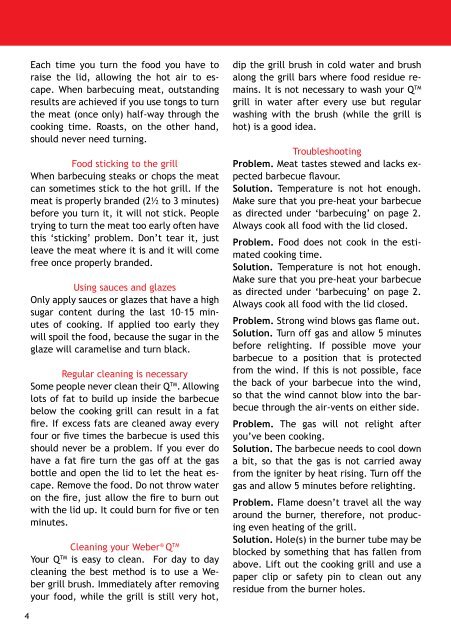Australian Cooking with the Weber® Q.TM
Australian Cooking with the Weber® Q.TM
Australian Cooking with the Weber® Q.TM
You also want an ePaper? Increase the reach of your titles
YUMPU automatically turns print PDFs into web optimized ePapers that Google loves.
4<br />
Each time you turn <strong>the</strong> food you have to<br />
raise <strong>the</strong> lid, allowing <strong>the</strong> hot air to escape.<br />
When barbecuing meat, outstanding<br />
results are achieved if you use tongs to turn<br />
<strong>the</strong> meat (once only) half-way through <strong>the</strong><br />
cooking time. Roasts, on <strong>the</strong> o<strong>the</strong>r hand,<br />
should never need turning.<br />
Food sticking to <strong>the</strong> grill<br />
When barbecuing steaks or chops <strong>the</strong> meat<br />
can sometimes stick to <strong>the</strong> hot grill. If <strong>the</strong><br />
meat is properly branded (2½ to 3 minutes)<br />
before you turn it, it will not stick. People<br />
trying to turn <strong>the</strong> meat too early often have<br />
this ‘sticking’ problem. Don’t tear it, just<br />
leave <strong>the</strong> meat where it is and it will come<br />
free once properly branded.<br />
Using sauces and glazes<br />
Only apply sauces or glazes that have a high<br />
sugar content during <strong>the</strong> last 10–15 minutes<br />
of cooking. If applied too early <strong>the</strong>y<br />
will spoil <strong>the</strong> food, because <strong>the</strong> sugar in <strong>the</strong><br />
glaze will caramelise and turn black.<br />
Regular cleaning is necessary<br />
Some people never clean <strong>the</strong>ir Q <strong>TM</strong> . Allowing<br />
lots of fat to build up inside <strong>the</strong> barbecue<br />
below <strong>the</strong> cooking grill can result in a fat<br />
fire. If excess fats are cleaned away every<br />
four or five times <strong>the</strong> barbecue is used this<br />
should never be a problem. If you ever do<br />
have a fat fire turn <strong>the</strong> gas off at <strong>the</strong> gas<br />
bottle and open <strong>the</strong> lid to let <strong>the</strong> heat escape.<br />
Remove <strong>the</strong> food. Do not throw water<br />
on <strong>the</strong> fire, just allow <strong>the</strong> fire to burn out<br />
<strong>with</strong> <strong>the</strong> lid up. It could burn for five or ten<br />
minutes.<br />
Cleaning your Weber ® Q <strong>TM</strong><br />
Your Q <strong>TM</strong> is easy to clean. For day to day<br />
cleaning <strong>the</strong> best method is to use a Weber<br />
grill brush. Immediately after removing<br />
your food, while <strong>the</strong> grill is still very hot,<br />
dip <strong>the</strong> grill brush in cold water and brush<br />
along <strong>the</strong> grill bars where food residue remains.<br />
It is not necessary to wash your Q <strong>TM</strong><br />
grill in water after every use but regular<br />
washing <strong>with</strong> <strong>the</strong> brush (while <strong>the</strong> grill is<br />
hot) is a good idea.<br />
Troubleshooting<br />
Problem. Meat tastes stewed and lacks expected<br />
barbecue flavour.<br />
Solution. Temperature is not hot enough.<br />
Make sure that you pre-heat your barbecue<br />
as directed under ‘barbecuing’ on page 2.<br />
Always cook all food <strong>with</strong> <strong>the</strong> lid closed.<br />
Problem. Food does not cook in <strong>the</strong> estimated<br />
cooking time.<br />
Solution. Temperature is not hot enough.<br />
Make sure that you pre-heat your barbecue<br />
as directed under ‘barbecuing’ on page 2.<br />
Always cook all food <strong>with</strong> <strong>the</strong> lid closed.<br />
Problem. Strong wind blows gas flame out.<br />
Solution. Turn off gas and allow 5 minutes<br />
before relighting. If possible move your<br />
barbecue to a position that is protected<br />
from <strong>the</strong> wind. If this is not possible, face<br />
<strong>the</strong> back of your barbecue into <strong>the</strong> wind,<br />
so that <strong>the</strong> wind cannot blow into <strong>the</strong> barbecue<br />
through <strong>the</strong> air-vents on ei<strong>the</strong>r side.<br />
Problem. The gas will not relight after<br />
you’ve been cooking.<br />
Solution. The barbecue needs to cool down<br />
a bit, so that <strong>the</strong> gas is not carried away<br />
from <strong>the</strong> igniter by heat rising. Turn off <strong>the</strong><br />
gas and allow 5 minutes before relighting.<br />
Problem. Flame doesn’t travel all <strong>the</strong> way<br />
around <strong>the</strong> burner, <strong>the</strong>refore, not producing<br />
even heating of <strong>the</strong> grill.<br />
Solution. Hole(s) in <strong>the</strong> burner tube may be<br />
blocked by something that has fallen from<br />
above. Lift out <strong>the</strong> cooking grill and use a<br />
paper clip or safety pin to clean out any<br />
residue from <strong>the</strong> burner holes.





